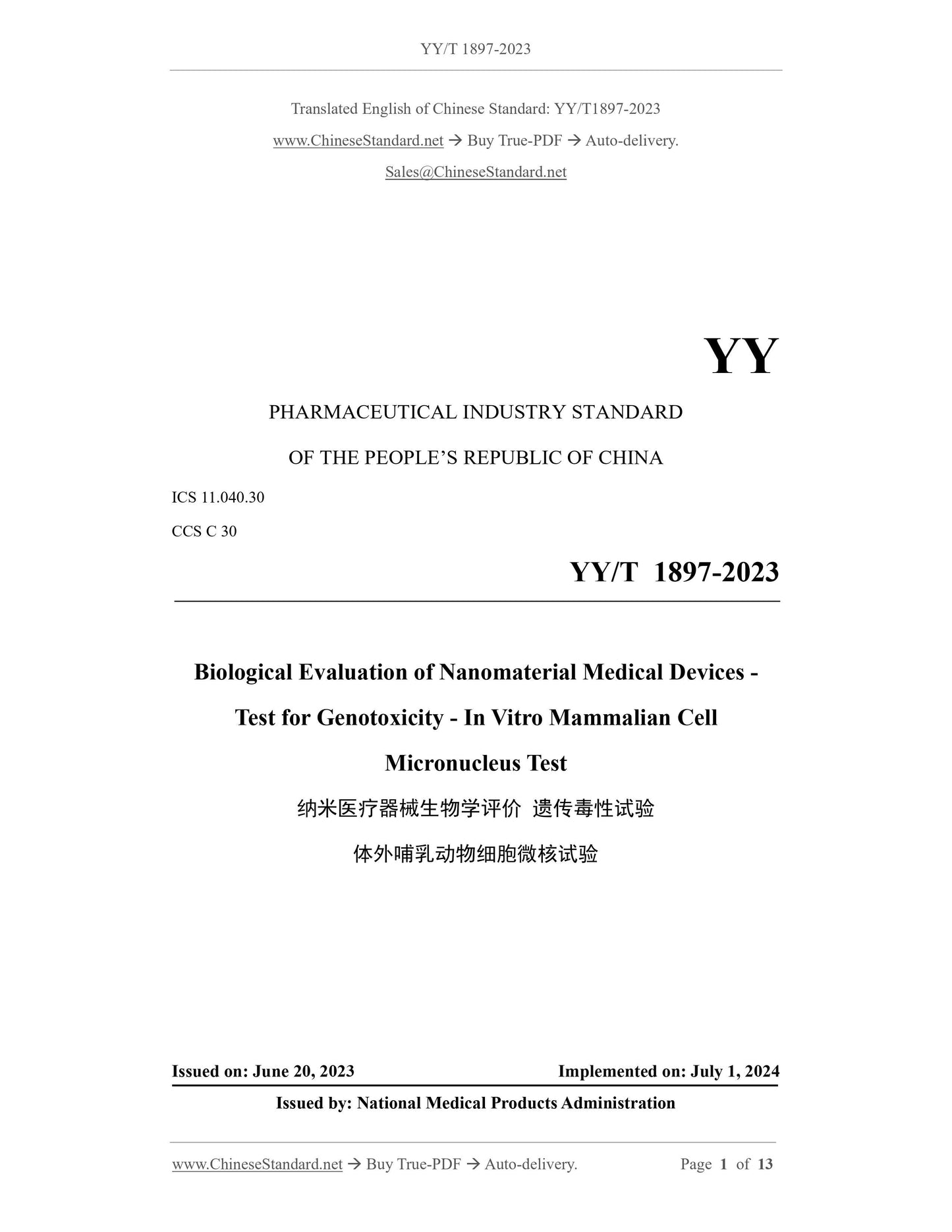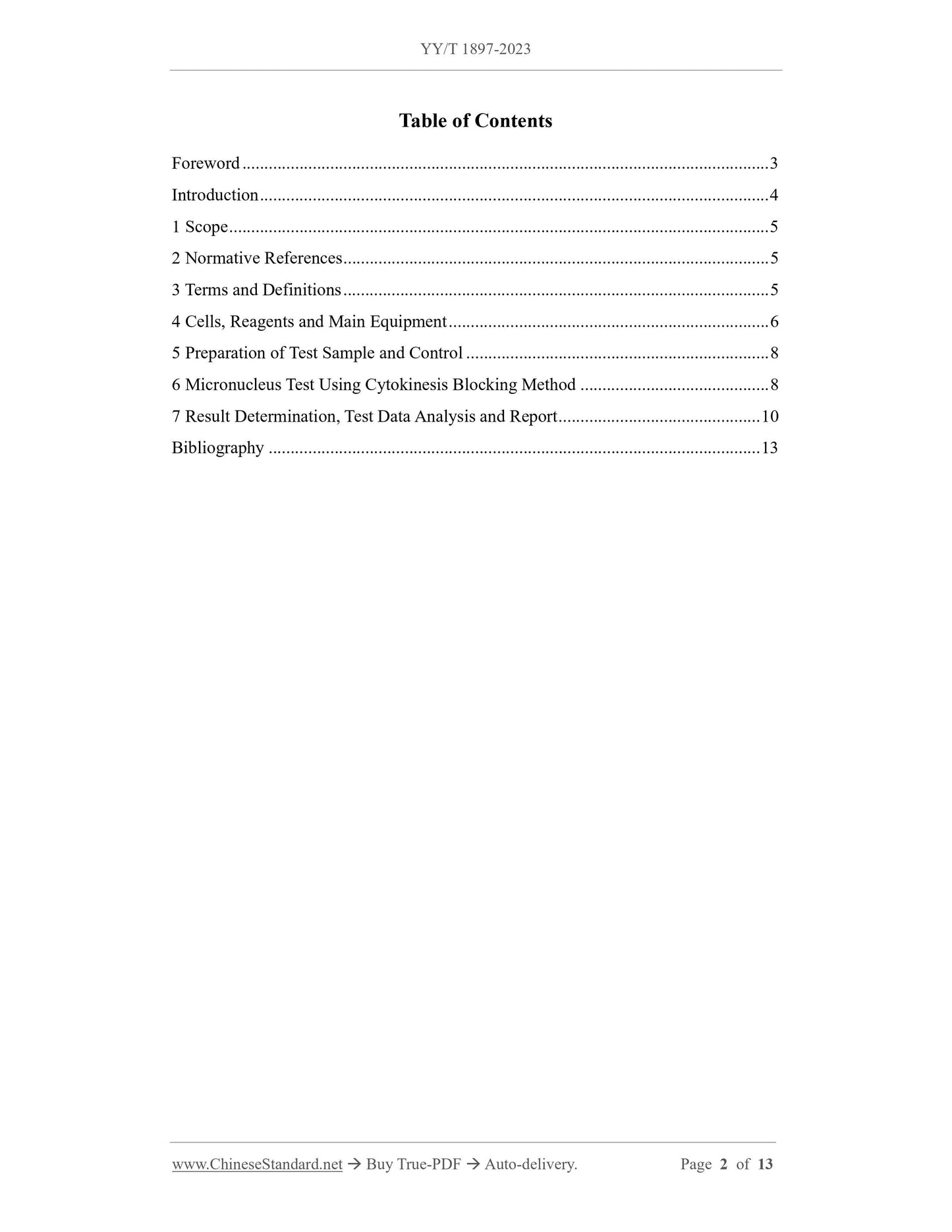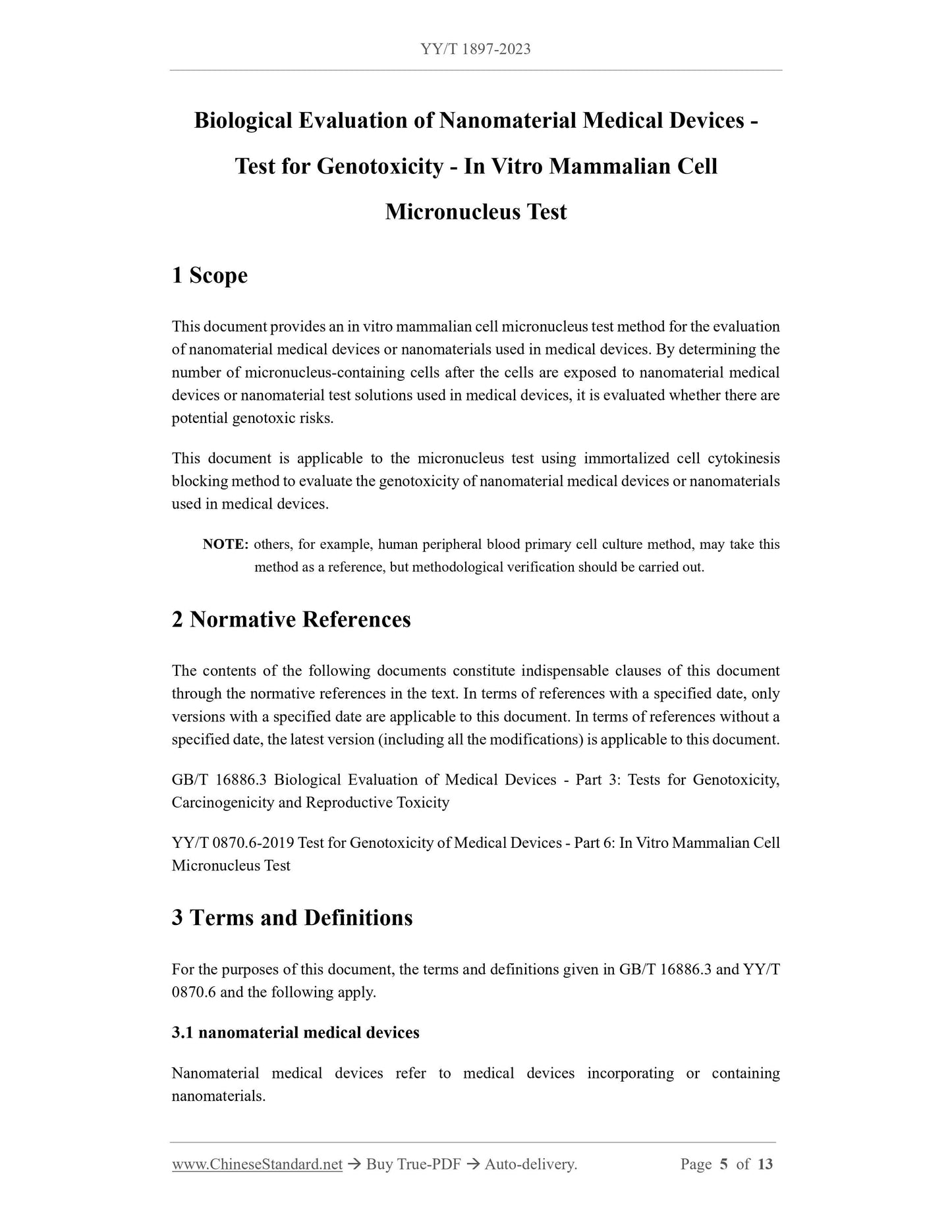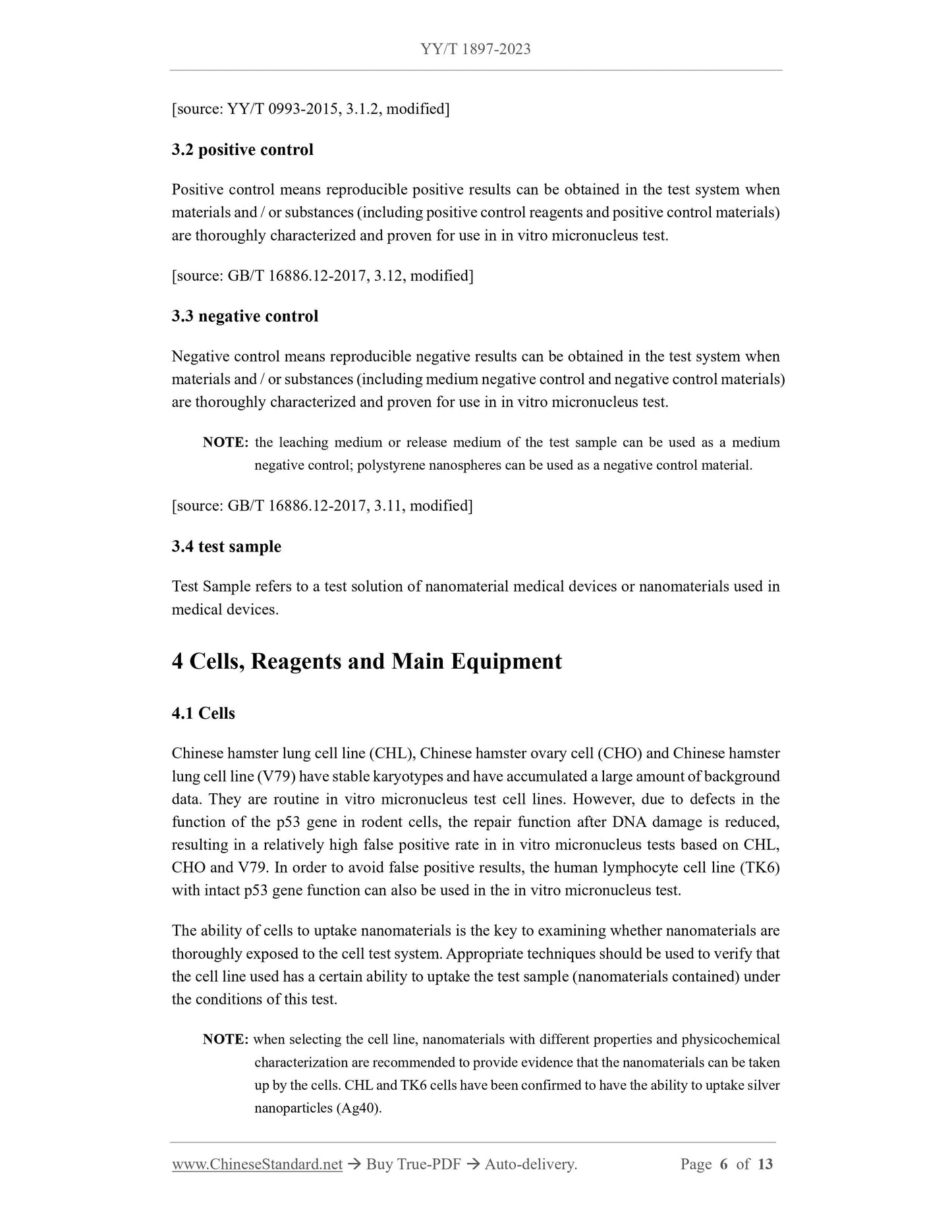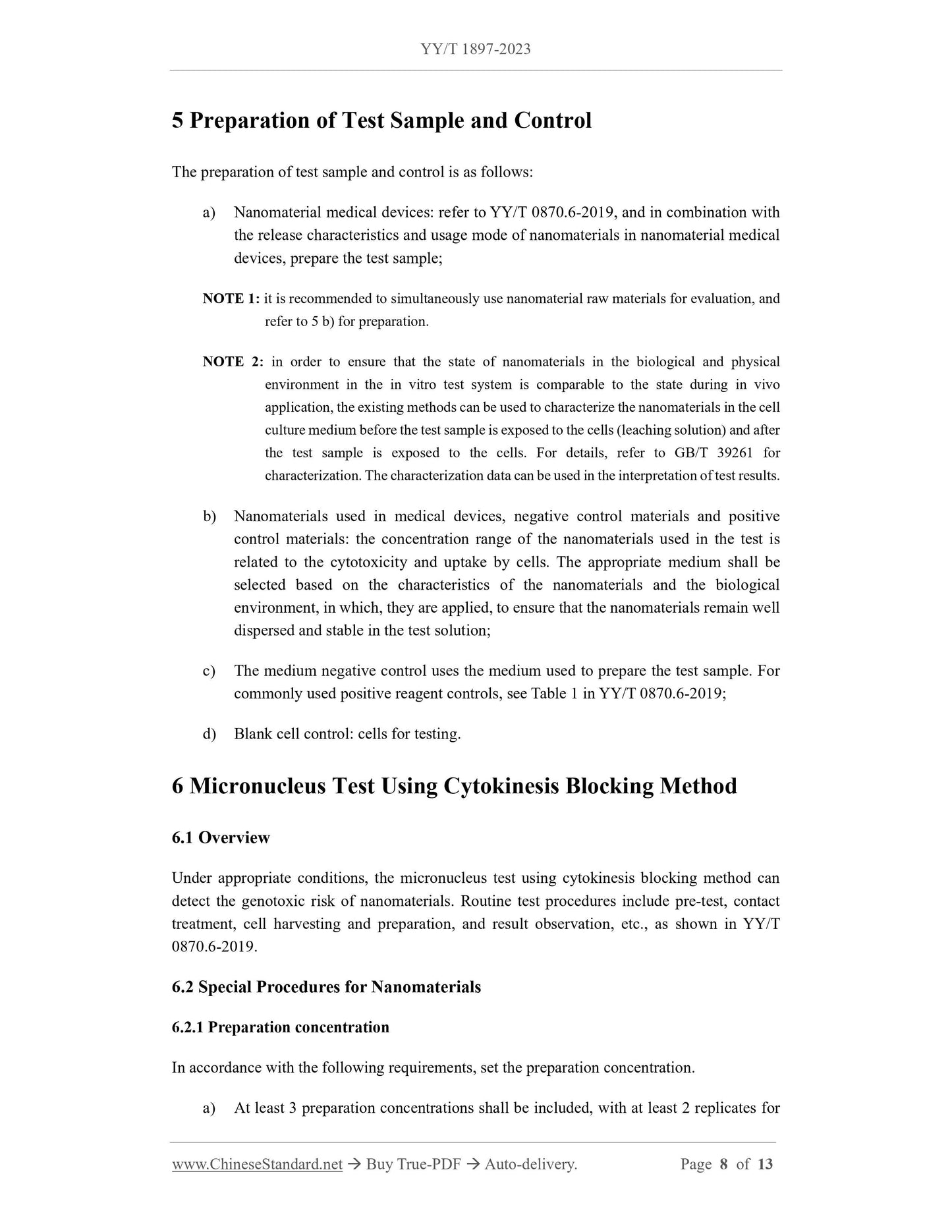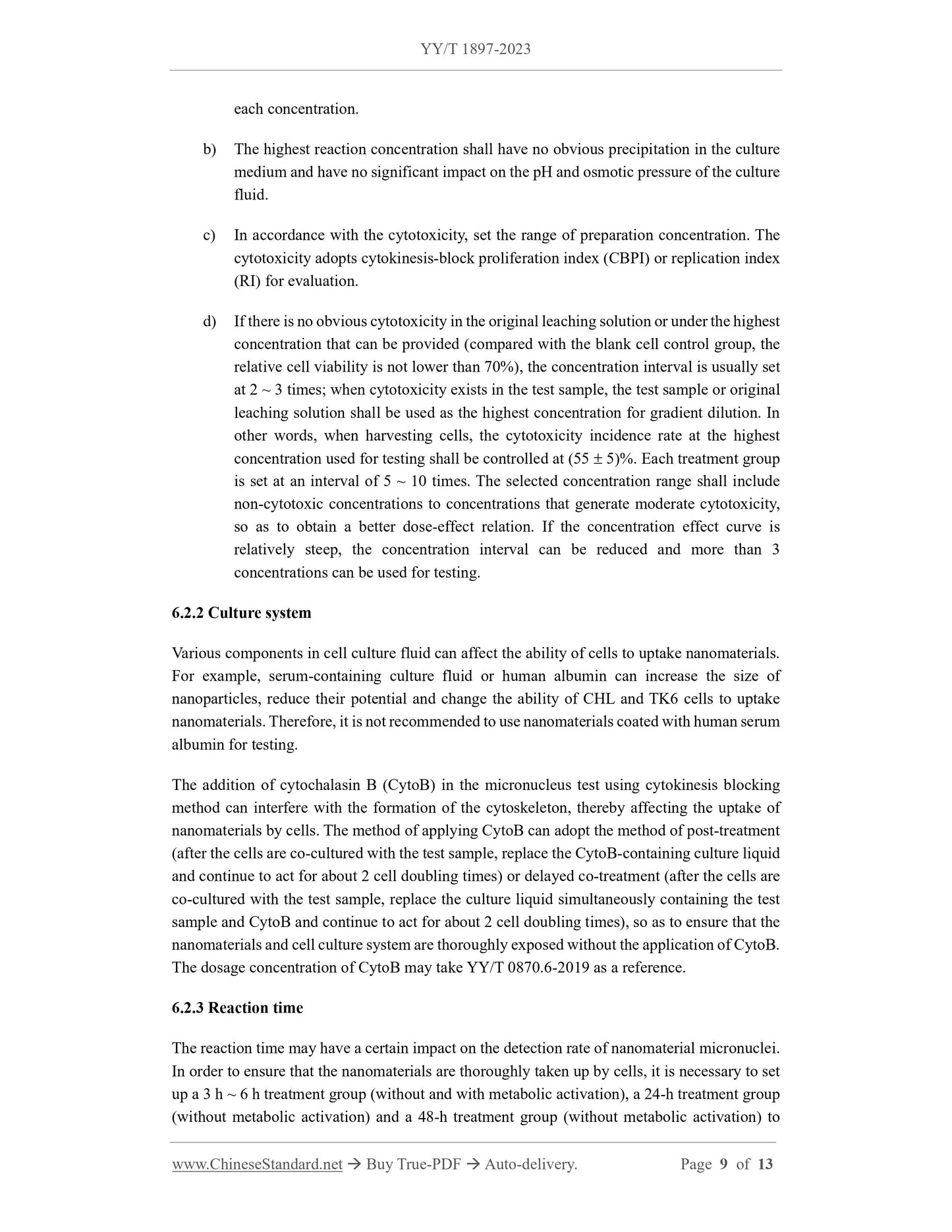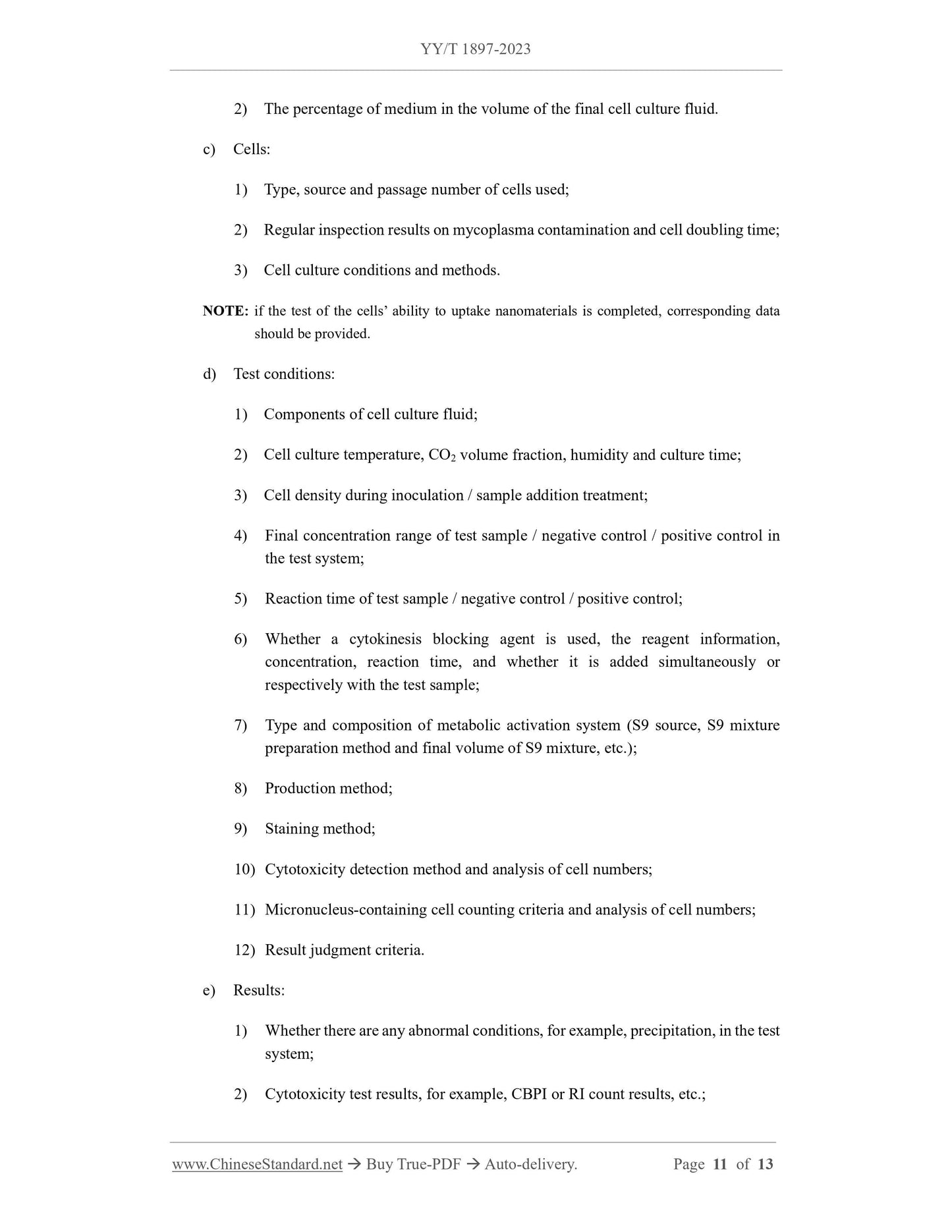PayPal, credit cards. Download editable-PDF and invoice in 1 second!
YY/T 1897-2023 English PDF (YYT1897-2023)
YY/T 1897-2023 English PDF (YYT1897-2023)
Precio habitual
$200.00 USD
Precio habitual
Precio de oferta
$200.00 USD
Precio unitario
/
por
Los gastos de envío se calculan en la pantalla de pago.
No se pudo cargar la disponibilidad de retiro
Delivery: 3 seconds. Download true-PDF + Invoice.
Get QUOTATION in 1-minute: Click YY/T 1897-2023
Historical versions: YY/T 1897-2023
Preview True-PDF (Reload/Scroll if blank)
YY/T 1897-2023: Biological evaluation of nanomedical devices Genotoxicity test In vitro mammalian cell micronucleus test
YY/T 1897-2023
YY
PHARMACEUTICAL INDUSTRY STANDARD
OF THE PEOPLE’S REPUBLIC OF CHINA
ICS 11.040.30
CCS C 30
Biological Evaluation of Nanomaterial Medical Devices -
Test for Genotoxicity - In Vitro Mammalian Cell
Micronucleus Test
ISSUED ON: JUNE 20, 2023
IMPLEMENTED ON: JULY 1, 2024
Issued by: National Medical Products Administration
Table of Contents
Foreword ... 3
Introduction ... 4
1 Scope ... 5
2 Normative References ... 5
3 Terms and Definitions ... 5
4 Cells, Reagents and Main Equipment ... 6
5 Preparation of Test Sample and Control ... 8
6 Micronucleus Test Using Cytokinesis Blocking Method ... 8
7 Result Determination, Test Data Analysis and Report ... 10
Bibliography ... 13
Biological Evaluation of Nanomaterial Medical Devices -
Test for Genotoxicity - In Vitro Mammalian Cell
Micronucleus Test
1 Scope
This document provides an in vitro mammalian cell micronucleus test method for the evaluation
of nanomaterial medical devices or nanomaterials used in medical devices. By determining the
number of micronucleus-containing cells after the cells are exposed to nanomaterial medical
devices or nanomaterial test solutions used in medical devices, it is evaluated whether there are
potential genotoxic risks.
This document is applicable to the micronucleus test using immortalized cell cytokinesis
blocking method to evaluate the genotoxicity of nanomaterial medical devices or nanomaterials
used in medical devices.
NOTE: others, for example, human peripheral blood primary cell culture method, may take this
method as a reference, but methodological verification should be carried out.
2 Normative References
The contents of the following documents constitute indispensable clauses of this document
through the normative references in the text. In terms of references with a specified date, only
versions with a specified date are applicable to this document. In terms of references without a
specified date, the latest version (including all the modifications) is applicable to this document.
GB/T 16886.3 Biological Evaluation of Medical Devices - Part 3: Tests for Genotoxicity,
Carcinogenicity and Reproductive Toxicity
YY/T 0870.6-2019 Test for Genotoxicity of Medical Devices - Part 6: In Vitro Mammalian Cell
Micronucleus Test
3 Terms and Definitions
For the purposes of this document, the terms and definitions given in GB/T 16886.3 and YY/T
0870.6 and the following apply.
3.1 nanomaterial medical devices
Nanomaterial medical devices refer to medical devices incorporating or containing
nanomaterials.
[source: YY/T 0993-2015, 3.1.2, modified]
3.2 positive control
Positive control means reproducible positive results can be obtained in the test system when
materials and / or substances (including positive control reagents and positive control materials)
are thoroughly characterized and proven for use in in vitro micronucleus test.
[source: GB/T 16886.12-2017, 3.12, modified]
3.3 negative control
Negative control means reproducible negative results can be obtained in the test system when
materials and / or substances (including medium negative control and negative control materials)
are thoroughly characterized and proven for use in in vitro micronucleus test.
NOTE: the leaching medium or release medium of the test sample can be used as a medium
negative control; polystyrene nanospheres can be used as a negative control material.
[source: GB/T 16886.12-2017, 3.11, modified]
3.4 test sample
Test Sample refers to a test solution of nanomaterial medical devices or nanomaterials used in
medical devices.
4 Cells, Reagents and Main Equipment
4.1 Cells
Chinese hamster lung cell line (CHL), Chinese hamster ovary cell (CHO) and Chinese hamster
lung cell line (V79) have stable karyotypes and have accumulated a large amount of background
data. They are routine in vitro micronucleus test cell lines. However, due to defects in the
function of the p53 gene in rodent cells, the repair function after DNA damage is reduced,
resulting in a relatively high false positive rate in in vitro micronucleus tests based on CHL,
CHO and V79. In order to avoid false positive results, the human lymphocyte cell line (TK6)
with intact p53 gene function can also be used in the in vitro micronucleus test.
The ability of cells to uptake nanomaterials is the key to examining whether nanomaterials are
thoroughly exposed to the cell test system. Appropriate techniques should be used to verify that
the cell line used has a certain ability to uptake the test sample (nanomaterials contained) under
the conditions of this test.
NOTE: when selecting the cell line, nanomaterials with different properties and physicochemical
characterization are recommended to provide evidence that the nanomaterials can be taken
up by the cells. CHL and TK6 cells have been confirmed to have the ability to uptake silver
nanoparticles (Ag40).
5 Preparation of Test Sample and Control
The preparation of test sample and control is as follows:
a) Nanomaterial medical devices: refer to YY/T 0870.6-2019, and in combination with
the release characteristics and usage mode of nanomaterials in nanomaterial medical
devices, prepare the test sample;
NOTE 1: it is recommended to simultaneously use nanomaterial raw materials for evaluation, and
refer to 5 b) for preparation.
NOTE 2: in order to ensure that the state of nanomaterials in the biological and physical
environment in the in vitro test system is comparable to the state during in vivo
application, the existing methods can be used to characterize the nanomaterials in the cell
culture medium before the test sample is exposed to the cells (leaching solution) and after
the test sample is exposed to the cells. For details, refer to GB/T 39261 for
characterization. The characterization data can be used in the interpretation of test results.
b) Nanomaterials used in medical devices, negative control materials and positive
control materials: the concentration range of the nanomaterials used in the test is
related to the cytotoxicity and uptake by cells. The appropriate medium shall be
selected based on the characteristics of the nanomaterials and the biological
environment, in which, they are applied, to ensure that the nanomaterials remain well
dispersed and stable in the test solution;
c) The medium negative control uses the medium used to prepare the test sample. For
commonly used positive reagent controls, see Table 1 in YY/T 0870.6-2019;
d) Blank cell control: cells for testing.
6 Micronucleus Test Using Cytokinesis Blocking Method
6.1 Overview
Under appropriate conditions, the micronucleus test using cytokinesis blocking method can
detect the genotoxic risk of nanomaterials. Routine test procedures include pre-test, contact
treatment, cell harvesting and preparation, and result observation, etc., as shown in YY/T
0870.6-2019.
6.2 Special Procedures for Nanomaterials
6.2.1 Preparation concentration
In accordance with the following requirements, set the preparation concentration.
a) At least 3 preparation concentrations shall be included, with at least 2 replicates for
each concentration.
b) The highest reaction concentration shall have no obvious precipitation in the culture
medium and have no significant impact on the pH and osmotic pressure of the culture
fluid.
c) In accordance with the cytotoxicity, set the range of preparation concentration. The
cytotoxicity adopts cytokinesis-block pr...
Get QUOTATION in 1-minute: Click YY/T 1897-2023
Historical versions: YY/T 1897-2023
Preview True-PDF (Reload/Scroll if blank)
YY/T 1897-2023: Biological evaluation of nanomedical devices Genotoxicity test In vitro mammalian cell micronucleus test
YY/T 1897-2023
YY
PHARMACEUTICAL INDUSTRY STANDARD
OF THE PEOPLE’S REPUBLIC OF CHINA
ICS 11.040.30
CCS C 30
Biological Evaluation of Nanomaterial Medical Devices -
Test for Genotoxicity - In Vitro Mammalian Cell
Micronucleus Test
ISSUED ON: JUNE 20, 2023
IMPLEMENTED ON: JULY 1, 2024
Issued by: National Medical Products Administration
Table of Contents
Foreword ... 3
Introduction ... 4
1 Scope ... 5
2 Normative References ... 5
3 Terms and Definitions ... 5
4 Cells, Reagents and Main Equipment ... 6
5 Preparation of Test Sample and Control ... 8
6 Micronucleus Test Using Cytokinesis Blocking Method ... 8
7 Result Determination, Test Data Analysis and Report ... 10
Bibliography ... 13
Biological Evaluation of Nanomaterial Medical Devices -
Test for Genotoxicity - In Vitro Mammalian Cell
Micronucleus Test
1 Scope
This document provides an in vitro mammalian cell micronucleus test method for the evaluation
of nanomaterial medical devices or nanomaterials used in medical devices. By determining the
number of micronucleus-containing cells after the cells are exposed to nanomaterial medical
devices or nanomaterial test solutions used in medical devices, it is evaluated whether there are
potential genotoxic risks.
This document is applicable to the micronucleus test using immortalized cell cytokinesis
blocking method to evaluate the genotoxicity of nanomaterial medical devices or nanomaterials
used in medical devices.
NOTE: others, for example, human peripheral blood primary cell culture method, may take this
method as a reference, but methodological verification should be carried out.
2 Normative References
The contents of the following documents constitute indispensable clauses of this document
through the normative references in the text. In terms of references with a specified date, only
versions with a specified date are applicable to this document. In terms of references without a
specified date, the latest version (including all the modifications) is applicable to this document.
GB/T 16886.3 Biological Evaluation of Medical Devices - Part 3: Tests for Genotoxicity,
Carcinogenicity and Reproductive Toxicity
YY/T 0870.6-2019 Test for Genotoxicity of Medical Devices - Part 6: In Vitro Mammalian Cell
Micronucleus Test
3 Terms and Definitions
For the purposes of this document, the terms and definitions given in GB/T 16886.3 and YY/T
0870.6 and the following apply.
3.1 nanomaterial medical devices
Nanomaterial medical devices refer to medical devices incorporating or containing
nanomaterials.
[source: YY/T 0993-2015, 3.1.2, modified]
3.2 positive control
Positive control means reproducible positive results can be obtained in the test system when
materials and / or substances (including positive control reagents and positive control materials)
are thoroughly characterized and proven for use in in vitro micronucleus test.
[source: GB/T 16886.12-2017, 3.12, modified]
3.3 negative control
Negative control means reproducible negative results can be obtained in the test system when
materials and / or substances (including medium negative control and negative control materials)
are thoroughly characterized and proven for use in in vitro micronucleus test.
NOTE: the leaching medium or release medium of the test sample can be used as a medium
negative control; polystyrene nanospheres can be used as a negative control material.
[source: GB/T 16886.12-2017, 3.11, modified]
3.4 test sample
Test Sample refers to a test solution of nanomaterial medical devices or nanomaterials used in
medical devices.
4 Cells, Reagents and Main Equipment
4.1 Cells
Chinese hamster lung cell line (CHL), Chinese hamster ovary cell (CHO) and Chinese hamster
lung cell line (V79) have stable karyotypes and have accumulated a large amount of background
data. They are routine in vitro micronucleus test cell lines. However, due to defects in the
function of the p53 gene in rodent cells, the repair function after DNA damage is reduced,
resulting in a relatively high false positive rate in in vitro micronucleus tests based on CHL,
CHO and V79. In order to avoid false positive results, the human lymphocyte cell line (TK6)
with intact p53 gene function can also be used in the in vitro micronucleus test.
The ability of cells to uptake nanomaterials is the key to examining whether nanomaterials are
thoroughly exposed to the cell test system. Appropriate techniques should be used to verify that
the cell line used has a certain ability to uptake the test sample (nanomaterials contained) under
the conditions of this test.
NOTE: when selecting the cell line, nanomaterials with different properties and physicochemical
characterization are recommended to provide evidence that the nanomaterials can be taken
up by the cells. CHL and TK6 cells have been confirmed to have the ability to uptake silver
nanoparticles (Ag40).
5 Preparation of Test Sample and Control
The preparation of test sample and control is as follows:
a) Nanomaterial medical devices: refer to YY/T 0870.6-2019, and in combination with
the release characteristics and usage mode of nanomaterials in nanomaterial medical
devices, prepare the test sample;
NOTE 1: it is recommended to simultaneously use nanomaterial raw materials for evaluation, and
refer to 5 b) for preparation.
NOTE 2: in order to ensure that the state of nanomaterials in the biological and physical
environment in the in vitro test system is comparable to the state during in vivo
application, the existing methods can be used to characterize the nanomaterials in the cell
culture medium before the test sample is exposed to the cells (leaching solution) and after
the test sample is exposed to the cells. For details, refer to GB/T 39261 for
characterization. The characterization data can be used in the interpretation of test results.
b) Nanomaterials used in medical devices, negative control materials and positive
control materials: the concentration range of the nanomaterials used in the test is
related to the cytotoxicity and uptake by cells. The appropriate medium shall be
selected based on the characteristics of the nanomaterials and the biological
environment, in which, they are applied, to ensure that the nanomaterials remain well
dispersed and stable in the test solution;
c) The medium negative control uses the medium used to prepare the test sample. For
commonly used positive reagent controls, see Table 1 in YY/T 0870.6-2019;
d) Blank cell control: cells for testing.
6 Micronucleus Test Using Cytokinesis Blocking Method
6.1 Overview
Under appropriate conditions, the micronucleus test using cytokinesis blocking method can
detect the genotoxic risk of nanomaterials. Routine test procedures include pre-test, contact
treatment, cell harvesting and preparation, and result observation, etc., as shown in YY/T
0870.6-2019.
6.2 Special Procedures for Nanomaterials
6.2.1 Preparation concentration
In accordance with the following requirements, set the preparation concentration.
a) At least 3 preparation concentrations shall be included, with at least 2 replicates for
each concentration.
b) The highest reaction concentration shall have no obvious precipitation in the culture
medium and have no significant impact on the pH and osmotic pressure of the culture
fluid.
c) In accordance with the cytotoxicity, set the range of preparation concentration. The
cytotoxicity adopts cytokinesis-block pr...
Share
